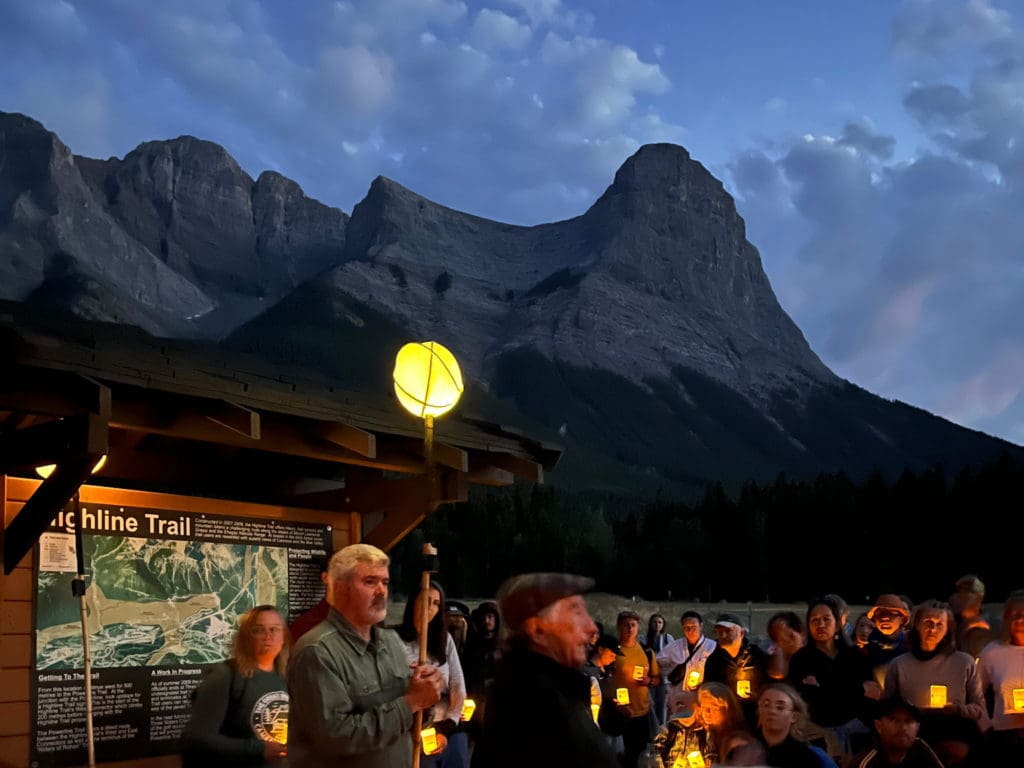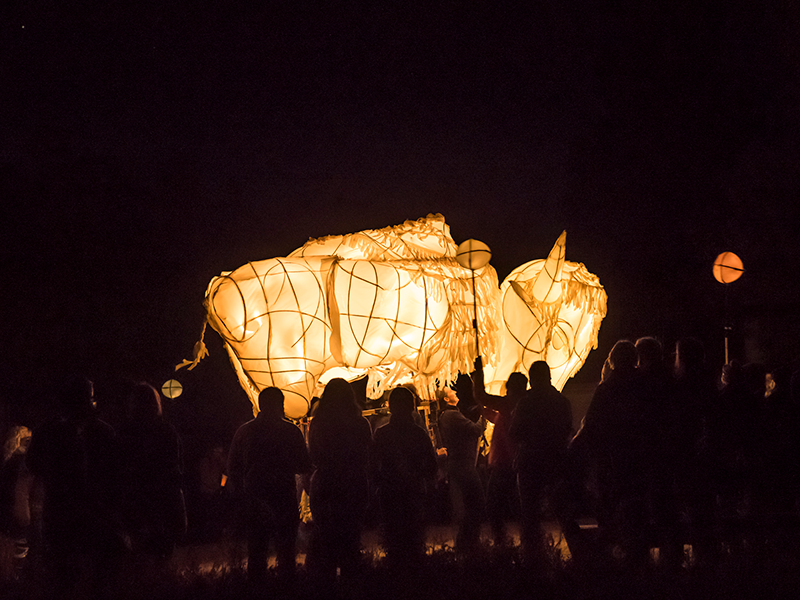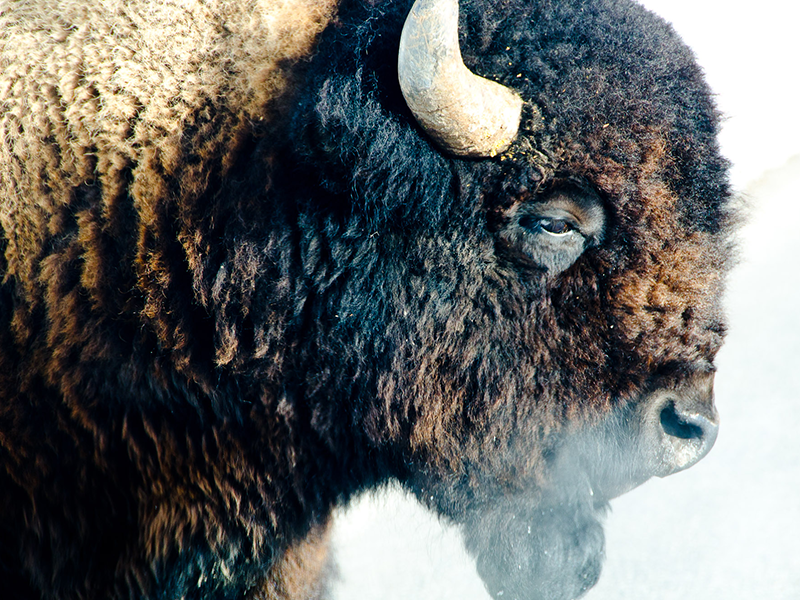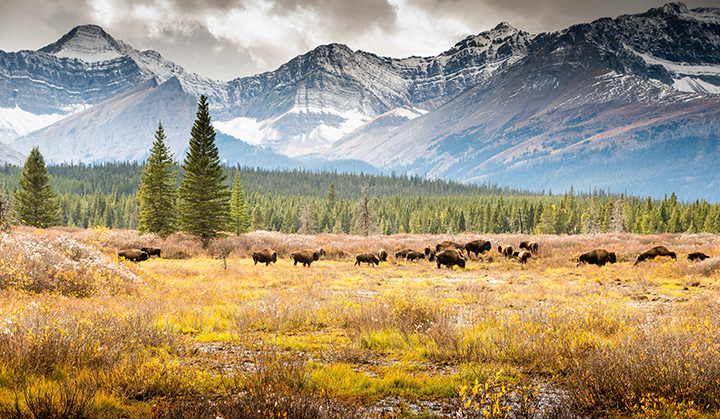Illuminating Iinni’s story in Alberta’s Bow Valley
This summer, Y2Y was honored to support the Iniskim, Return of the Buffalo performance for the first time in Canmore, Alberta. As with the animal whose story it tells, the August 11 performance brought a powerful presence and important message to the Bow Valley that night.
What follows is a glimpse at the evening, the significance of the story behind Iniskim, and what bringing back buffalo means for nature and people.
Being with light and darkness
As the sun lowered for its grand finale of the day, a full moon and glimmering stars lit the August sky in its place. The Three Sisters mountains (Nuu ooks Kadtamii ki li staki tis — which refers to the three Buffalo Mountains in Blackfoot), towering over the Bow Valley in Chuwapchipchiyan Kudi Bi (Canmore in Îyârhe Nakoda language), were transformed into shadows.
A few hundred people were anticipating the performance of Iniskim, Return of the Buffalo. Holding the lanterns they had just assembled with the help of friends, they were then guided through a winding forest path to the performance space at Quarry Lake.
There, they were immersed in storytelling through lantern sculpture, puppetry, spoken word, and songs in Blackfoot and Stoney, dance and drumming. These art-forms worked together harmoniously to share the story of the return of the buffalo to the landscape.

This performance by the Canadian Academy of Mask and Puppetry, with creative direction from members of the Blood Tribe (Kainai) and Stoney Nakoda First Nations, and guidance from Elders, celebrates the Buffalo and the species’ reintroduction into the natural ecosystem of Banff National Park.
Iniskim, Return of the Buffalo, is about Na’pi — the trickster in Blackfoot culture — who has hidden the buffalo in the mountains. It is both a gathering and a teaching that shines light and truth upon the land.
Amethyst First Rider is a member of the Blood Tribe. She has been leader in the performing arts community in North America for more than 20 years, and is one of the co-creators of Iniskim.
“Na’pi in Blackfoot describes a beautiful and informative relationship with light,” says First Rider. “When you see the puppets and Iinnii (buffalo), you begin to feel a relationship with light and darkness, and the beautiful landscape we are blessed to be in.”
“Na’pi in Blackfoot describes a beautiful and informative relationship with light. When you see the puppets and Iinnii (buffalo), you begin to feel a relationship with light and darkness, and the beautiful landscape we are blessed to be in.”
Amethyst First Rider, co-creator of Iniskim, Return of the Buffalo
Josh Welsh, Y2Y program manager, helped organize and attended the show. He recalls the powerful voice and story of the narrator booming through the valley. “It was a very moving experience and inspired much the same awe that the majestic Rocky Mountains provided as the storyteller’s backdrop.”
This voice belongs to Lorne Duquette, a Cree storyteller who has been a professional actor for more than 20 years, and is also a Powwow dancer and singer.
“What intrigued me about this role was the chance, as someone who is Cree, to learn first-hand about these Blackfoot traditions and culture — things I did not know before,” says Duquette. “Learning this Iniskim story was a way for me to become a student of humanity. That just involved me as an actor taking the role, and doing my best to tell it.”
“It’s one thing to wonder or read about buffalo,” adds Duquette. “The way Iniskim brought this story forward allowed for the audience to learn and observe what it might be like to be amongst buffalo in a safe space.”

Bringing buffalo back home
Buffalo once numbered in the tens of millions in North America. They represent the identity of the First Nations of the great plains, and have long provided food, clothing, shelter and tools.
In the late 1800s, the transformation of the land through settlement brought the buffalo close to extinction. This was a profound loss to Indigenous Peoples for whom buffalo was central to every aspect of life.
In an ongoing Blackfoot language revitalization project, the Kainai Ecosystem Protection Association (KEPA) said that the buffalo, among other species such as the grizzly bear, are iconic beings for the Blackfoot. “They were inextricably interrelated to the very being of Blackfoot people sustenance-wise, spiritually, culturally and linguistically. The disappearance of iconic symbols for a culture means the beginning of the disappearance of the culture and language that goes with it.”
Many people have worked to return buffalo to the land and repair these relationships. After many years, we are seeing hope for buffalo’s return, including within the Yellowstone to Yukon region.

In 2017, buffalo were reintroduced to Banff National Park, where the herd is thriving today. It was a joyous moment for many. Iniskim, Return of the Buffalo was created in celebration of that reintroduction.
“When discussions in our community about returning the buffalo started, Elders provided guidance and told us, ‘When you’re ready, you’re going to need friends, you can’t do it on your own.’ So, we made friends with a number of people and groups,” says First Rider, whose work has been integral in bringing buffalo back across Canada and the U.S. through the Buffalo Treaty. “The support from NGOs like Y2Y makes it possible to celebrate Iinnii.”
The reintroduction of buffalo is closely tied to the health of the landscapes where they roam.
“Once you start talking about buffalo, you are also talking about land. When we put buffalo on the land, we want them to have beautiful grass to eat, land to roam. It’s all connected,” explains First Rider. “The buffalo lantern show is an idea of communicating and educating the community about the rematriation of buffalo, and of course the experience on the land.”
Iniskim was created to call attention to an amazing story. It enriches relationships between people, and with the land, and strengthens our ability to learn from each other.
“The buffalo brings people together. The Iniskim story reconnects us with the bigger landscape. Everyone comes away from the performance with a different learning. To me, the diversity of perspective that the arts bring is magical.”
Marie-Eve Marchand, Executive Director, International Buffalo Relations Institute
“The buffalo brings people together,” says Marie-Eve Marchand, who co-ordinated the movement to bring the plains bison back to Banff National Park, supports the implementation of the Buffalo Treaty as the Executive Director of the International Buffalo Relations Institute, and is part of the team that conceived Iniskim.
“The Iniskim story reconnects us with the bigger landscape. Everyone comes away from the performance with a different learning. To me, the diversity of perspective that the arts bring is magical.”
Y2Y works with Indigenous partners to achieve our shared vision of a landscape where people and nature can thrive. Not only does your support of Y2Y help make these collaborations possible, it illuminates hope for buffalo and people once again.
Continue your learning journey
Watch this panel discussion hosted by Y2Y in 2022 featuring founding directors of the International Buffalo Relations Institute: Dr. Leroy Little Bear, Dr. Tasha Hubbard and Kyra Northwest, discussing the role Buffalo Consciousness, Buffalo Rematriation and ecological and cultural renewal play in North America.


